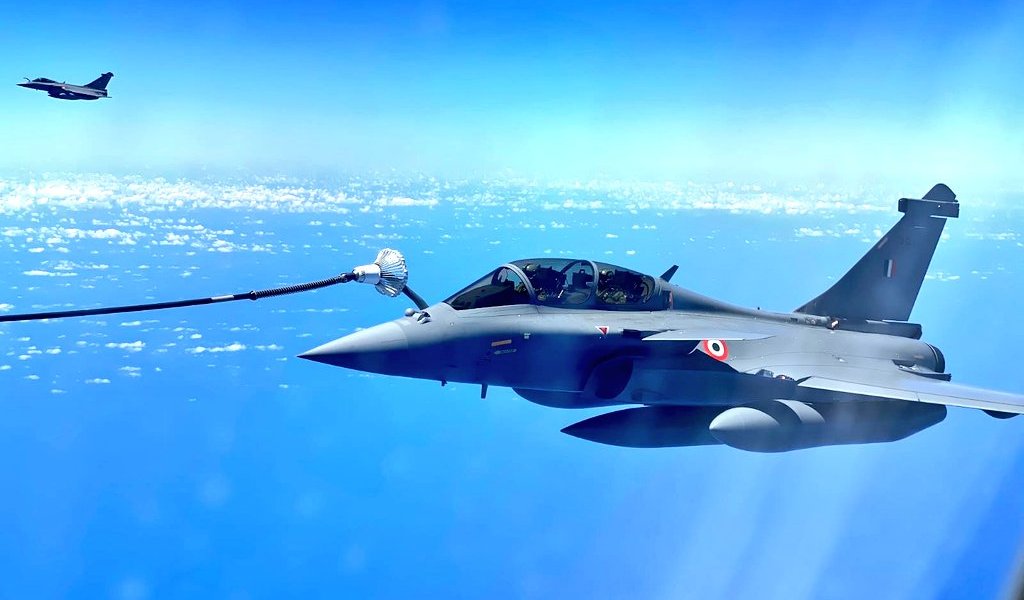
A 36th Rafale fighter jet, the last airframe of an Indian order placed in 2016, will be delivered to the Indian Air Force a month from now, completing what France hopes is only the first order for the jet. The final airframe, actually the first to be built for India, has remained in France ever since deliveries to the IAF began in October 2019. The specimen has been a testbed for a list of India-specific software, electronic warfare and sensor enhancements that needed to be certified alongside proprietary software on the jet.
Livefist can confirm that the India-specific enhancements have in fact grown beyond the list of enhancements originally agreed upon. These mostly pertain to advanced communication systems, at least two additional custom sensor modes and the installation of Indian electronic warfare equipment. The Indian Air Force’s request for additional enhancements was accepted since they melded seamlessly into the testing that was already underway and did not present a procedural, cost overrun or time delay. It is understood that the additional enhancements flowed, at least in part, from the IAF’s use of Rafale fighters starting mid 2020 in the Ladakh sector amidst a large — and ongoing — military standoff with China.
A senior IAF officer associated with the Rafale program tells Livefist, “The Rafale is fully operational now in Indian service. The last couple of years have presented fresh perspective on the jets and how we use them. There were a handful of tweaks we wanted in the final retrofit of enhancements, which we wanted to effect without delay. The partnership has proven very effective in quickly accepting and including those enhancements. The ‘Rafale-I’ will therefore be an even more enhanced version of the fighter that we finalised.”
The process of updating the existing Rafales has begun, and will continue into 2023.
Dassault and the French Government have pushed hard for the Indian Air Force to quickly double its order of 36 Rafales since 2019 when deliveries began, but a combination of factors has meant the IAF is faced once again with a contest where it must choose (or rather the Government of India must choose) which path to take.
Indian Air Force Rafales were first spotted with SCALP load-outs in October last year, weeks after the weapon system achieved operational status in the fleet.
The two IAF Rafale squadrons — one in north India’s Ambala and the other in eastern India’s Hasimara — have been in a fully operational state for over a year now. With the India-specific enhancements now tested and validated, they will be retro-fitted across the fleet of 35 jets in service. You can read all about the specifications of the IAF Rafale in this detailed piece here.
While the Rafale in Indian service is a modified version of the F3R standard, the spirally improved F4 standard with India-specific enhancements is on offer to the Indian Air Force for its multi-role fighter aircraft (MRFA) program, which envisages buying and locally building 114 jets. In that veritable re-play of the troubled and finally aborted medium multirole combat aircraft (MMRCA) program, the Rafale goes up theoretically against the jet it outplayed for the 2016 order — the Eurofighter Typhoon — but more realistically is in a face-off with two American jets, the F-15 Eagle II and the latest modified version of the F-16, recast for the Indian contest as the F-21 Super Viper.
You can read about Boeing’s twin fighter pitches in India here, a story first detailed by Livefist, and Lockheed Martin’s continued push to create unignorable sourcing and manufacturing capacity in India. Lockheed Martin held its 9th annual Indian suppliers conference in Bengaluru earlier this month. Both U.S. companies have steadily boosted local production of an escalating complexity of systems and subsystems for global defence products, a thrust unlikely to slow down as the MRFA, in a matter of speaking, heats up.

We should buy 36 more and keep 72 planes and don’t get into tot.
Also buy 72 Sukhoi and upgrade it to latest standards with Indian avionics and radar.
Further 20 mig 29 can be purchased at throw away price and upgrade it to upg standards.
Many countries may give up old mig 29 and it’s better to grab them and upgrade in India.this way we can increase fight strength immediately.for long term Tejas orca and amca should be made